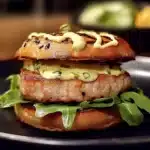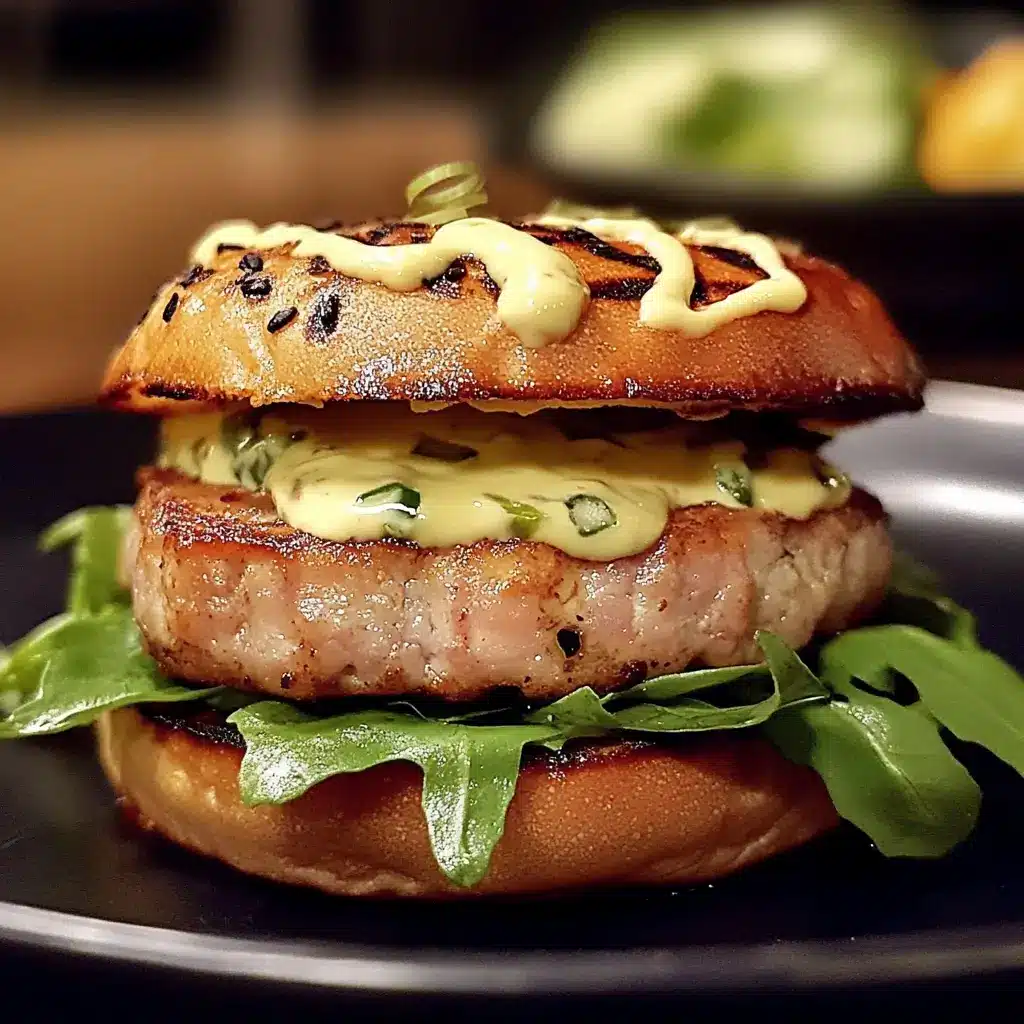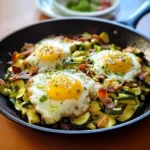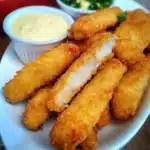There are moments in the kitchen that redefine a staple, and for my family, the humble burger experienced such a revolution the first time these Asian-Inspired Tuna Burgers hit the grill. I remember the slight skepticism – tuna burgers? It sounded perhaps a little too healthy, maybe a bit… bland? Oh, how wrong we were. That first bite was a revelation: the perfectly seared, ruby-red center of the high-quality tuna, the savory depth from soy and sesame, the fresh zing of ginger and scallions, all brought together by a creamy, fiery kick from the wasabi mayonnaise. It wasn’t just a burger; it was an experience. Since then, it’s become a requested favorite, especially during warmer months when we crave something substantial yet refreshingly different. It’s the recipe I pull out when I want to impress guests with minimal fuss but maximum flavor impact. It transforms a simple meal into something special, proving that burgers don’t always need beef to be incredibly satisfying and exciting. The delightful contrast between the rich, tender tuna and the pungent, creamy mayo, nestled in a soft bun with crisp toppings, is simply culinary magic. This isn’t just dinner; it’s a flavor journey that we happily embark on again and again.
Ingredients
This recipe yields 4 generous tuna burgers. Here’s what you’ll need to gather:
For the Tuna Patties:
- Sushi-Grade Tuna: 1.5 lbs (about 680g) fresh, high-quality Ahi or Yellowfin tuna loin, skinless and boneless. Crucial note: Ensure it’s labeled “sushi-grade” or “sashimi-grade” from a trusted fishmonger, as the center will be served medium-rare.
- Panko Breadcrumbs: 1/2 cup (Japanese-style breadcrumbs for light, airy texture). You can substitute regular breadcrumbs if needed, but panko is preferred.
- Large Egg: 1, lightly beaten (acts as a binder).
- Low-Sodium Soy Sauce (or Tamari for Gluten-Free): 2 tablespoons (adds umami and saltiness).
- Toasted Sesame Oil: 1 teaspoon (provides a distinct nutty aroma and flavor).
- Fresh Ginger: 1 tablespoon, finely grated (use a microplane for best results).
- Garlic: 1 large clove, minced or finely grated.
- Scallions (Green Onions): 1/4 cup, thinly sliced (both white and green parts).
- Fresh Cilantro (Optional): 2 tablespoons, chopped (adds a fresh, herbaceous note – omit if you’re not a fan).
- Black Pepper: 1/4 teaspoon, freshly ground.
- Salt: Pinch to taste (be mindful of the soy sauce).
- High Smoke-Point Oil for Cooking: 1-2 tablespoons (e.g., avocado oil, grapeseed oil, canola oil).
For the Wasabi Mayo:
- Good Quality Mayonnaise: 1/2 cup (Japanese Kewpie mayo is excellent here, but any good quality full-fat mayo works).
- Wasabi Paste: 1 to 2 teaspoons (adjust based on your heat preference and the potency of your wasabi paste – start with less, you can always add more). Note: Most commercial “wasabi” paste is primarily horseradish, coloring, and mustard. If you can find real wasabi (hon-wasabi), use it for a cleaner, more nuanced heat.
- Lime Juice: 1 teaspoon, freshly squeezed (adds brightness and cuts through the richness).
- Low-Sodium Soy Sauce: 1/2 teaspoon (optional, adds a touch more umami).
For Assembly:
- Burger Buns: 4 high-quality buns (Brioche buns work beautifully, but sesame seed, potato rolls, or whole wheat buns are also great choices).
- Lettuce: Butter lettuce, romaine, or green leaf lettuce leaves.
- Optional Toppings (Choose your favorites):
- Sliced Avocado
- Thinly Sliced Tomato
- Pickled Ginger (Gari)
- Thinly Sliced Cucumber
- Wakame Seaweed Salad
- Microgreens or Sprouts
- Thinly Sliced Red Onion
- Crispy Fried Onions or Shallots
- Grilled Pineapple Rings
Understanding the Key Ingredients:
- The Tuna: The quality of your tuna is non-negotiable for this recipe. Sushi-grade signifies that the fish is high quality and has been handled according to specific guidelines (like flash-freezing) to minimize the risk of parasites, making it safer for consumption when not fully cooked. Look for a firm texture, a deep red or pink color (depending on the species), and a fresh, clean smell (it should smell like the ocean, not “fishy”). If buying frozen sushi-grade tuna, ensure it’s thawed properly in the refrigerator overnight. Avoid using canned tuna or tuna steaks not intended for raw/rare consumption.
- Panko: These Japanese breadcrumbs are made from white bread without crusts, processed into large flakes, and then dried. This results in a lighter, airier, and crispier texture compared to standard breadcrumbs, which helps keep the tuna burger light rather than dense.
- Wasabi Paste: The pungent kick is essential. Start with a smaller amount, mix it into the mayo, and taste. The heat can vary significantly between brands. Remember that the heat from wasabi (or horseradish) is different from chili heat – it hits the sinuses more directly and dissipates faster.
- Toasted Sesame Oil: A little goes a long way. This oil adds a deep, nutty, roasted flavor characteristic of many Asian cuisines. Ensure you’re using toasted sesame oil, which is darker and more flavorful than untoasted sesame oil.
Instructions
Follow these steps carefully for perfectly seared, flavorful tuna burgers:
- Prepare the Tuna:
- Ensure your tuna is very cold. If needed, place it in the freezer for 10-15 minutes before dicing (this makes it firmer and easier to cut).
- Using a very sharp knife, dice the tuna loin into small, uniform pieces – aim for about 1/4-inch cubes. You want texture, so don’t mince it into a paste like ground meat. Work relatively quickly to keep the fish cold.
- Place the diced tuna into a large, chilled mixing bowl. Chilling the bowl beforehand helps maintain the tuna’s temperature.
- Make the Tuna Patty Mixture:
- To the bowl with the diced tuna, add the panko breadcrumbs, lightly beaten egg, soy sauce (or tamari), toasted sesame oil, grated ginger, minced garlic, sliced scallions, optional chopped cilantro, black pepper, and a small pinch of salt.
- Using your hands or a spatula, gently mix the ingredients until just combined. Be careful not to overmix! Overmixing can make the burgers tough and dense. You want the ingredients evenly distributed but the tuna cubes should still largely retain their shape.
- Form the Patties:
- Divide the mixture into 4 equal portions.
- Gently form each portion into a patty, about 3/4 to 1 inch thick and roughly the diameter of your burger buns. Don’t pack them too tightly. Handle them gently to keep the texture light.
- Place the formed patties on a plate or baking sheet lined with parchment paper.
- (Optional but Recommended) Cover the patties loosely with plastic wrap and refrigerate for at least 15-30 minutes. This helps them firm up and hold their shape better during cooking.
- Make the Wasabi Mayo:
- While the patties are chilling (or just before cooking), prepare the wasabi mayo. In a small bowl, combine the mayonnaise, 1 teaspoon of wasabi paste, fresh lime juice, and the optional 1/2 teaspoon of soy sauce.
- Whisk everything together until smooth and well combined.
- Taste the mayo. If you desire more heat, add more wasabi paste, 1/4 teaspoon at a time, mixing well after each addition, until it reaches your preferred level of spiciness.
- Cover the wasabi mayo and refrigerate until ready to use. This can be made a day in advance.
- Prepare for Cooking:
- If desired, lightly toast your burger buns. You can do this on the grill, in the pan before cooking the tuna, or under the broiler for a minute or two (watch carefully!). Set aside.
- Prepare your chosen toppings: wash lettuce, slice tomato/avocado/cucumber, etc. Have everything ready for assembly.
- Cook the Tuna Burgers:
- Heat your chosen cooking oil (1-2 tablespoons) in a large skillet (cast iron works wonderfully for a great sear) or on a flat-top grill over medium-high heat. The pan needs to be properly hot to achieve a good sear quickly. You should see a slight shimmer in the oil, or a drop of water should sizzle and evaporate instantly.
- Carefully place the chilled tuna patties in the hot skillet, ensuring not to overcrowd the pan (cook in batches if necessary).
- Sear the patties for approximately 2-4 minutes per side for a medium-rare center (adjust timing based on patty thickness and desired doneness). The goal is to get a beautiful, golden-brown crust on the outside while keeping the inside tender and pink/red.
- Important: Avoid pressing down on the burgers with a spatula while they cook, as this squeezes out juices. Let the heat do the work of creating the crust. Resist the urge to move them around too much in the first couple of minutes to allow the sear to develop.
- For medium, cook slightly longer, perhaps 4-5 minutes per side. Cooking tuna burgers well-done is generally not recommended as the tuna can become dry and tough, losing its delicate flavor and texture.
- Once cooked to your liking, remove the patties from the skillet and let them rest for a minute or two.
- Assemble the Burgers:
- Spread a generous layer of wasabi mayo on both the top and bottom toasted buns.
- Place a lettuce leaf on the bottom bun.
- Top with the cooked tuna patty.
- Add your desired optional toppings (avocado, pickled ginger, tomato, etc.).
- Place the top bun over the toppings.
- Serve immediately and enjoy the explosion of flavors!
Nutrition Facts
- Servings: This recipe makes 4 tuna burgers.
- Calories per Serving (Approximate): Around 550 – 700 kcal per burger.
Disclaimer: This nutritional estimate is approximate and applies primarily to the tuna patty and wasabi mayo before adding the bun and extensive toppings. The final calorie count can vary significantly based on:
* The specific type and size of the burger bun used (brioche buns are typically higher in calories than whole wheat or standard white buns).
* The amount and type of toppings added (avocado, extra mayo, cheese if used, will increase calories and fat).
* The exact amount of oil used for cooking.
* The specific brands of ingredients (mayonnaise, panko, soy sauce).
These burgers are an excellent source of lean protein and healthy omega-3 fatty acids from the tuna.
Preparation Time
- Prep Time: 20-25 minutes (includes dicing tuna, mixing patties, making mayo)
- Chill Time (Optional): 15-30 minutes
- Cook Time: 5-8 minutes (per side searing time)
- Total Time: Approximately 30 – 40 minutes (excluding optional chilling time), making this a relatively quick meal for such impressive results.
How to Serve
Serving these Asian-Inspired Tuna Burgers is all about complementing their unique flavors and textures. Here are some ideas:
- The Vessel (Bun Choices):
- Brioche Buns: Soft, slightly sweet, and rich, they beautifully complement the savory tuna and spicy mayo. Toast them lightly with butter for extra decadence.
- Sesame Seed Buns: A classic choice that adds a subtle nutty flavor and visual appeal.
- Potato Rolls: Soft and slightly sweet, offering a tender bite.
- Ciabatta Rolls: Offer a chewier texture and sturdy base if you’re loading up on toppings.
- Lettuce Wraps: For a low-carb, gluten-free option, serve the tuna patty wrapped in large, crisp lettuce leaves (like iceberg, butter, or romaine hearts).
- Essential Toppings:
- Wasabi Mayo: Don’t skimp! Spread generously on both buns.
- Crisp Lettuce: Provides a fresh crunch and barrier.
- Flavor-Enhancing Toppings (Choose a Few):
- Creaminess: Sliced avocado is almost mandatory – its coolness balances the wasabi heat.
- Pickled Element: Pickled ginger (gari, like sushi ginger) adds a sharp, sweet tang that cuts richness. Quick pickled cucumbers or pickled daikon radish are also fantastic.
- Freshness: Thinly sliced cucumber, ripe tomato slices, microgreens, or alfalfa sprouts.
- Crunch: Crispy fried onions or shallots offer savory crunch. Wakame seaweed salad adds oceanic flavor and slippery texture.
- Sweet & Savory: A thin slice of grilled pineapple can add a surprising tropical twist.
- Side Dish Pairings:
- Asian-Inspired Sides:
- Edamame: Steamed and lightly salted, or sautéed with garlic and chili flakes.
- Asian Slaw: A vinegar-based slaw (no mayo) with shredded cabbage, carrots, cilantro, and a sesame-ginger dressing.
- Seaweed Salad: A classic Japanese side dish (wakame).
- Sunomono (Japanese Cucumber Salad): Thinly sliced cucumbers in a light rice vinegar dressing.
- Classic Burger Sides (with a Twist):
- Sweet Potato Fries: Their natural sweetness pairs well with the Asian flavors. Serve with a side of the wasabi mayo for dipping!
- Furikake Fries: Regular fries tossed with Japanese furikake seasoning (a mix often containing seaweed, sesame seeds, salt, and sugar).
- Tempura Onion Rings: Light and crispy.
- Lighter Options:
- Simple Green Salad: Mixed greens with a light miso-ginger or sesame vinaigrette.
- Asian-Inspired Sides:
- Drink Pairings:
- Beer: Crisp Japanese lagers (like Sapporo, Asahi, Kirin Ichiban) or a light American lager. A Belgian-style Witbier can also work well.
- Wine: A crisp, high-acid white wine like Sauvignon Blanc, Pinot Grigio, or a dry Riesling. A dry Rosé is also a good option.
- Sake: Chilled Junmai or Ginjo sake complements the flavors beautifully.
- Non-Alcoholic: Iced green tea, sparkling water with lime, ginger ale, or a quality non-alcoholic beer.
Additional Tips
Maximize your tuna burger success with these five key tips:
- Prioritize Tuna Freshness and Quality: This cannot be stressed enough. Since the tuna is served medium-rare, using high-quality, sushi-grade tuna from a reputable source is paramount for both flavor and safety. Look for tuna that is firm, smells fresh (like the sea, not fishy), and has a vibrant, translucent color. If using frozen, ensure it’s specifically marked as sushi/sashimi grade and thaw it safely in the refrigerator. Avoid previously frozen tuna that isn’t designated as safe for raw consumption.
- Keep Everything Cold: Tuna is delicate. Keeping the fish, your mixing bowl, and even your hands cold during the dicing and mixing process helps maintain the integrity and texture of the fish. It also helps keep it within a safe temperature zone. Don’t let the diced tuna or the formed patties sit out at room temperature for extended periods. The chilling step before cooking isn’t just for shape retention; it also ensures the center stays cool while the outside sears.
- Handle and Mix Gently: The goal is a tender, flaky tuna burger, not a dense fish puck. When mixing the patty ingredients, use a light touch and combine only until everything is incorporated. Overmixing develops the proteins, resulting in a tougher, chewier texture. Similarly, when forming the patties, be gentle – don’t compact them excessively.
- Achieve the Perfect Sear: High heat and a short cooking time are key. Ensure your pan or grill is properly preheated before adding the patties. You want to create a flavorful, caramelized crust quickly without overcooking the interior. Use an oil with a high smoke point (like avocado or grapeseed oil) to prevent burning. Don’t overcrowd the pan, as this lowers the temperature and leads to steaming rather than searing. Let the patties cook undisturbed for the first couple of minutes on each side to develop that beautiful crust.
- Taste and Adjust Seasoning (Especially the Mayo): Flavors can vary based on ingredients (saltiness of soy sauce, potency of wasabi, sweetness of mayo). Taste the wasabi mayo before serving and adjust the wasabi, lime juice, or soy sauce to your preference. Similarly, while the recipe provides base amounts for the patty seasoning, feel free to adjust slightly based on your taste, but remember the soy sauce already adds significant saltiness. Adding a tiny pinch of salt directly to the diced tuna before mixing can help enhance its flavor.
FAQ Section
Here are answers to some frequently asked questions about making Asian-Inspired Tuna Burgers:
- Q: Can I use canned tuna instead of fresh tuna?
- A: While you can make tuna patties with canned tuna, it results in a completely different dish. This specific recipe relies on the texture and flavor of fresh, high-quality tuna seared to medium-rare. Canned tuna is fully cooked and has a much softer, flakier texture that won’t hold up in the same way and cannot be served medium-rare. Using canned tuna would create more of a traditional tuna cake or tuna melt patty, not the steak-like burger experience intended here. For this recipe’s profile, fresh sushi-grade tuna is essential.
- Q: What exactly does “sushi-grade” or “sashimi-grade” tuna mean? Is it officially regulated?
- A: These terms generally indicate that the fish is of high quality, was handled with exceptional care, and often flash-frozen shortly after being caught to kill potential parasites, making it safer to consume raw or undercooked. However, these terms are not officially regulated by the FDA in the United States (regulations may vary elsewhere). It’s more of an industry term indicating suitability for raw applications. The most important factor is buying from a reputable and trusted fishmonger who understands sourcing and proper handling for fish intended for raw or rare consumption. Ask them directly if the tuna is suitable for searing rare.
- Q: Can I prepare these tuna burgers ahead of time?
- A: You can do some prep in advance. The wasabi mayo can be made up to 2-3 days ahead and stored in an airtight container in the refrigerator; its flavor might even meld and improve. You can also form the tuna patties a few hours ahead (up to 4-6 hours maximum, due to the raw fish). Keep them well-covered with plastic wrap on a parchment-lined plate in the coldest part of your refrigerator. However, for the best texture and flavor, the tuna burgers should be cooked just before serving. Reheating cooked tuna burgers often results in overcooking the center and drying them out.
- Q: Are these Asian-Inspired Tuna Burgers healthy?
- A: Generally, yes, they can be a very healthy option compared to traditional beef burgers. Tuna is a fantastic source of lean protein and heart-healthy omega-3 fatty acids. The patty itself uses minimal filler (panko) and relies on fresh ingredients. However, the overall healthiness depends heavily on the accompaniments:
- Bun: Choosing a whole-wheat bun over a rich brioche bun lowers calories and adds fiber. Using a lettuce wrap makes it low-carb.
- Mayo: Mayonnaise adds fat and calories. Be mindful of the portion size, or consider using a light mayonnaise (though the texture and flavor might differ slightly).
- Toppings: Loading up on fresh veggies is great. Avocado adds healthy fats but also calories. Fried toppings add less healthy fats.
- Cooking Method: Searing with minimal oil is relatively healthy. Avoid deep-frying.
- A: Generally, yes, they can be a very healthy option compared to traditional beef burgers. Tuna is a fantastic source of lean protein and heart-healthy omega-3 fatty acids. The patty itself uses minimal filler (panko) and relies on fresh ingredients. However, the overall healthiness depends heavily on the accompaniments:
- Q: I don’t like spicy food or wasabi. Can I still make this recipe?
- A: Absolutely! The wasabi mayo provides a signature kick, but you can easily modify or replace it.
- Omit the Wasabi: Simply make the mayo with just mayonnaise, lime juice, and maybe a pinch of soy sauce for a creamy, tangy spread.
- Reduce the Wasabi: Use a very small amount (like 1/4 teaspoon) for just a hint of its unique flavor without overwhelming heat.
- Substitute the Spice: Use Sriracha instead of wasabi for a different kind of chili heat (start with 1 tsp Sriracha mayo).
- Alternative Sauces: Skip the wasabi mayo altogether and try a ginger-lime aioli, a classic tartar sauce, a drizzle of teriyaki glaze, or even just plain high-quality mayonnaise. The tuna patty itself is flavorful enough to stand on its own with simpler condiments.
- A: Absolutely! The wasabi mayo provides a signature kick, but you can easily modify or replace it.

Asian-Inspired Tuna Burger Recipe
Ingredients
For the Tuna Patties:
- Sushi-Grade Tuna: 1.5 lbs (about 680g) fresh, high-quality Ahi or Yellowfin tuna loin, skinless and boneless. Crucial note: Ensure it’s labeled “sushi-grade” or “sashimi-grade” from a trusted fishmonger, as the center will be served medium-rare.
- Panko Breadcrumbs: 1/2 cup (Japanese-style breadcrumbs for light, airy texture). You can substitute regular breadcrumbs if needed, but panko is preferred.
- Large Egg: 1, lightly beaten (acts as a binder).
- Low-Sodium Soy Sauce (or Tamari for Gluten-Free): 2 tablespoons (adds umami and saltiness).
- Toasted Sesame Oil: 1 teaspoon (provides a distinct nutty aroma and flavor).
- Fresh Ginger: 1 tablespoon, finely grated (use a microplane for best results).
- Garlic: 1 large clove, minced or finely grated.
- Scallions (Green Onions): 1/4 cup, thinly sliced (both white and green parts).
- Fresh Cilantro (Optional): 2 tablespoons, chopped (adds a fresh, herbaceous note – omit if you’re not a fan).
- Black Pepper: 1/4 teaspoon, freshly ground.
- Salt: Pinch to taste (be mindful of the soy sauce).
- High Smoke-Point Oil for Cooking: 1-2 tablespoons (e.g., avocado oil, grapeseed oil, canola oil).
For the Wasabi Mayo:
- Good Quality Mayonnaise: 1/2 cup (Japanese Kewpie mayo is excellent here, but any good quality full-fat mayo works).
- Wasabi Paste: 1 to 2 teaspoons (adjust based on your heat preference and the potency of your wasabi paste – start with less, you can always add more). Note: Most commercial “wasabi” paste is primarily horseradish, coloring, and mustard. If you can find real wasabi (hon-wasabi), use it for a cleaner, more nuanced heat.
- Lime Juice: 1 teaspoon, freshly squeezed (adds brightness and cuts through the richness).
- Low-Sodium Soy Sauce: 1/2 teaspoon (optional, adds a touch more umami).
For Assembly:
- Burger Buns: 4 high-quality buns (Brioche buns work beautifully, but sesame seed, potato rolls, or whole wheat buns are also great choices).
- Lettuce: Butter lettuce, romaine, or green leaf lettuce leaves.
- Optional Toppings (Choose your favorites):
- Sliced Avocado
- Thinly Sliced Tomato
- Pickled Ginger (Gari)
- Thinly Sliced Cucumber
- Wakame Seaweed Salad
- Microgreens or Sprouts
- Thinly Sliced Red Onion
- Crispy Fried Onions or Shallots
- Grilled Pineapple Rings
Understanding the Key Ingredients:
- The Tuna: The quality of your tuna is non-negotiable for this recipe. Sushi-grade signifies that the fish is high quality and has been handled according to specific guidelines (like flash-freezing) to minimize the risk of parasites, making it safer for consumption when not fully cooked. Look for a firm texture, a deep red or pink color (depending on the species), and a fresh, clean smell (it should smell like the ocean, not “fishy”). If buying frozen sushi-grade tuna, ensure it’s thawed properly in the refrigerator overnight. Avoid using canned tuna or tuna steaks not intended for raw/rare consumption.
- Panko: These Japanese breadcrumbs are made from white bread without crusts, processed into large flakes, and then dried. This results in a lighter, airier, and crispier texture compared to standard breadcrumbs, which helps keep the tuna burger light rather than dense.
- Wasabi Paste: The pungent kick is essential. Start with a smaller amount, mix it into the mayo, and taste. The heat can vary significantly between brands. Remember that the heat from wasabi (or horseradish) is different from chili heat – it hits the sinuses more directly and dissipates faster.
- Toasted Sesame Oil: A little goes a long way. This oil adds a deep, nutty, roasted flavor characteristic of many Asian cuisines. Ensure you’re using toasted sesame oil, which is darker and more flavorful than untoasted sesame oil.
Instructions
- Prepare the Tuna:
- Ensure your tuna is very cold. If needed, place it in the freezer for 10-15 minutes before dicing (this makes it firmer and easier to cut).
- Using a very sharp knife, dice the tuna loin into small, uniform pieces – aim for about 1/4-inch cubes. You want texture, so don’t mince it into a paste like ground meat. Work relatively quickly to keep the fish cold.
- Place the diced tuna into a large, chilled mixing bowl. Chilling the bowl beforehand helps maintain the tuna’s temperature.
- Make the Tuna Patty Mixture:
- To the bowl with the diced tuna, add the panko breadcrumbs, lightly beaten egg, soy sauce (or tamari), toasted sesame oil, grated ginger, minced garlic, sliced scallions, optional chopped cilantro, black pepper, and a small pinch of salt.
- Using your hands or a spatula, gently mix the ingredients until just combined. Be careful not to overmix! Overmixing can make the burgers tough and dense. You want the ingredients evenly distributed but the tuna cubes should still largely retain their shape.
- Form the Patties:
- Divide the mixture into 4 equal portions.
- Gently form each portion into a patty, about 3/4 to 1 inch thick and roughly the diameter of your burger buns. Don’t pack them too tightly. Handle them gently to keep the texture light.
- Place the formed patties on a plate or baking sheet lined with parchment paper.
- (Optional but Recommended) Cover the patties loosely with plastic wrap and refrigerate for at least 15-30 minutes. This helps them firm up and hold their shape better during cooking.
- Make the Wasabi Mayo:
- While the patties are chilling (or just before cooking), prepare the wasabi mayo. In a small bowl, combine the mayonnaise, 1 teaspoon of wasabi paste, fresh lime juice, and the optional 1/2 teaspoon of soy sauce.
- Whisk everything together until smooth and well combined.
- Taste the mayo. If you desire more heat, add more wasabi paste, 1/4 teaspoon at a time, mixing well after each addition, until it reaches your preferred level of spiciness.
- Cover the wasabi mayo and refrigerate until ready to use. This can be made a day in advance.
- Prepare for Cooking:
- If desired, lightly toast your burger buns. You can do this on the grill, in the pan before cooking the tuna, or under the broiler for a minute or two (watch carefully!). Set aside.
- Prepare your chosen toppings: wash lettuce, slice tomato/avocado/cucumber, etc. Have everything ready for assembly.
- Cook the Tuna Burgers:
- Heat your chosen cooking oil (1-2 tablespoons) in a large skillet (cast iron works wonderfully for a great sear) or on a flat-top grill over medium-high heat. The pan needs to be properly hot to achieve a good sear quickly. You should see a slight shimmer in the oil, or a drop of water should sizzle and evaporate instantly.
- Carefully place the chilled tuna patties in the hot skillet, ensuring not to overcrowd the pan (cook in batches if necessary).
- Sear the patties for approximately 2-4 minutes per side for a medium-rare center (adjust timing based on patty thickness and desired doneness). The goal is to get a beautiful, golden-brown crust on the outside while keeping the inside tender and pink/red.
- Important: Avoid pressing down on the burgers with a spatula while they cook, as this squeezes out juices. Let the heat do the work of creating the crust. Resist the urge to move them around too much in the first couple of minutes to allow the sear to develop.
- For medium, cook slightly longer, perhaps 4-5 minutes per side. Cooking tuna burgers well-done is generally not recommended as the tuna can become dry and tough, losing its delicate flavor and texture.
- Once cooked to your liking, remove the patties from the skillet and let them rest for a minute or two.
- Assemble the Burgers:
- Spread a generous layer of wasabi mayo on both the top and bottom toasted buns.
- Place a lettuce leaf on the bottom bun.
- Top with the cooked tuna patty.
- Add your desired optional toppings (avocado, pickled ginger, tomato, etc.).
- Place the top bun over the toppings.
- Serve immediately and enjoy the explosion of flavors!
Nutrition
- Serving Size: One Normal Portion
- Calories: 550 – 700





